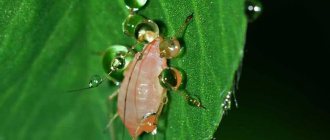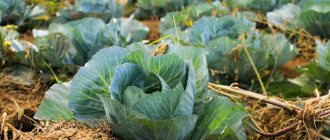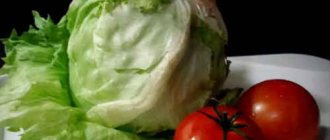Cabbage Transfer F1 is an early ripening hybrid of white cabbage, which occupies a significant share of the first vegetable market. The hybrid grows and bears fruit throughout Russia, tolerates weather vagaries, and rarely gets sick. The pulp has a wonderful taste and aroma.
| Landing location | Ripening time | View | Purpose | Origin | Maturation period | Weight |
| Open ground | Early ripening | White cabbage | Fresh, Cooking | Hybrid | 96-100 | 0,8–1,5 |
Description of the variety
The transfer was included in the state register of the Russian Federation in 1993. This hybrid is allowed for cultivation in all regions of the country, except for the northernmost corners of our country.
When describing Transfer cabbage, the first thing to note is its modest weight. The mass of heads of cabbage is only from 0.7 to 1.5 kg. They have a round shape. The cut forks are white. Density is average. There are voids around the periphery. The outside color is greenish-white. The inner stalk is short.
The rosette of the crop is semi-raised and compact. Cabbage leaves are round and slightly bubbly. They have a light green color. There is a waxy coating on their surface. There is slight waviness along the edge of the leaf.
The variety is recommended for fresh consumption. But it is also suitable for culinary processing.
Approximately 100 days pass from the first shoots to the moment of harvesting. Cabbage Transfer F1 ripens so quickly that it is considered ultra-early. This property gives an advantage when selling products on the market.
From 1 sq. m, you can harvest up to 7 kg of crop, which is more than the June cabbage variety. Product yield is 94%. And this is considered almost the highest indicator for an early ripening variety.
Description of the head of cabbage
The value of cabbage lies in a large set of vitamins and microelements important for the human body.
Description of the head of variety Transfer:
- round shape;
- average density;
- the presence of voids around the periphery;
- short stalk;
- the socket is compact and semi-raised;
- weight - from 0.7 to 1.5 kg.
Description of cabbage leaves:
- rounded;
- light green, with small bubbles;
- a protective waxy coating forms on the surface of the leaves;
- the edge of the leaf is slightly wavy;
- The outer color of the head of cabbage is greenish-white.
Advantages
Transfer F1 cabbage has a number of positive qualities that distinguish it from other varieties, and allow farmers and vegetable growers to choose it.
- Excellent taste.
- High productivity.
- Resistance to major diseases.
- Withstands temperature changes, cold snaps in spring and even frosts down to minus 5°C.
- The variety does not require special conditions and effort when growing.
- The heads of cabbage are not prone to cracking, are relatively dense and juicy.
- The harvest is stable and friendly. The period between the ripening of the first and last heads can be only 6-8 days. Another convenience is that they are approximately the same size.
- Excellent presentation.
- Cabbage easily tolerates transportation.
Features of growing the variety
In Siberia, the Urals and the Far East, Nadezhda cabbage, as a rule, is grown only by seedlings. In central Russia and the Moscow region, this variety can also be grown without seedlings, provided that the beds are protected from return frosts at first or using warm bed technology. When sowing seeds in open ground, the growing season is shortened by 15–18 days, since the plants do not “get sick” after transplantation. You can sow Nadezhda seeds in the garden at the end of April or the first ten days of May; in this case, the heads of cabbage will begin to ripen at the end of August or beginning of September.
Landing
When choosing Nadezhda cabbage seeds, preference should be given to well-known companies with a good reputation. The following agricultural companies can be recommended for purchasing planting material:
- SeDeK has been on the seed market since 1995.
- "Gavrish" - founded in 1993.
- “Altai Seeds” has been known on the market since 1995.
- “Search” has existed since 1990.
- "Aelita" - appeared in 1994.
Photo gallery: Nadezhda cabbage seeds from reliable producers
Seeds of Hope are sown for seedlings in the first half of April. In central Russia, plants are usually planted in a permanent place in the second half of May, depending on the weather. Seedlings can withstand frosts down to -5°C, and the favorable temperature for their growth is 15–17°C.
The process of growing seedlings of this variety does not have any special features. Before sowing, planting material is pre-treated in the usual ways: calibration, disinfection, soaking and hardening. Plant the seeds to a depth of 1 cm. After germination, maintain the temperature at night at 8–10°C, during the day at 12–15°C, lengthen the daylight hours with a fluorescent lamp to 12–15 hours and water moderately. After one or two true leaves appear, the seedlings dive. Then they are fed twice with complex mineral fertilizers and hardened off before planting in open ground. When 5-6 true leaves appear, they are planted in a permanent place.
Cabbage seedlings should have 5–6 true leaves
Nadezhda, like any other cabbage, grows best in fertile, slightly loamy and loamy soils with a neutral or slightly acidic reaction (pH 6.4–7.5). The acidity of the soil must be carefully controlled, since the Nadezhda variety is susceptible to clubroot disease, which spreads in acidic soils. If necessary, lime the soil.
Flaws
A description of the shortcomings of Transfer cabbage also deserves due attention. After all, when choosing a variety, it is very important to understand all the pros and cons of the culture. This is the only way to achieve the desired result.
The plant may be attacked by the cruciferous flea beetle. To avoid this, you need to sprinkle the cabbage with dry ash.
In addition, Transfer cabbage needs weeding, hilling and loosening of the soil. You need to make sure that the seedlings do not stretch out, otherwise the plant will weaken. Early varieties of cabbage are more often attacked by pests. They suffer because of weeds.
Cabbage Transfer F1 cannot be salted or fermented. It also does not tolerate long-term storage. Can only be used for fresh consumption, as well as in first and second courses.
Features of agricultural technology
Transfer cabbage can be grown either by seedlings or without seedlings. However, gardeners in most cases prefer the first option. This choice is associated with the desire to get a harvest at the beginning of summer. Residents of the southern and central regions sow early cabbage directly into open ground in April - May, when the threat of night frosts has passed.
Sowing seeds for seedlings
The best time to start sowing seeds for seedlings is the last days of March - the first ten days of April. In Siberia and the Urals, the start of sowing work is slightly shifted to a later time. In this matter, vegetable growers must focus on the weather conditions of a particular area.
Cabbage seeds have sprouted
Before sowing, the seeds must be disinfected if they are not covered with glaze. To do this, they are placed in a solution of potassium permanganate. The water is heated to 50 degrees. After 20 minutes, the material is cooled and slightly dried on a clean cloth.
Reference. Some gardeners additionally treat seeds with Epin or Zircon, which increases germination and has a beneficial effect on the immunity of seedlings.
It is very important to prepare suitable soil for growing seedlings. It should be nutritious, light, breathable. The level of acidity also matters. A neutral pH is suitable for all types of cabbage. The soil is bought in a store or made up of the following components:
- humus;
- bottom peat;
- turf;
- compost;
- sand.
Peat can be excluded from the list or taken in small quantities - no more than 10% of the total volume of land. The remaining components are taken in equal shares. The substrate is enriched with wood ash, mixed and poured with boiling water or a solution of potassium permanganate. This measure is aimed at destroying fungal spores and pathogenic bacteria.
For sowing, take a shallow box or individual containers. Seeds are planted 1 cm deep in moist soil. When using a common container, sowing is done according to a 3x5 cm pattern. The containers are covered with transparent film and left at room temperature.
Seedling care
When the shoots appear, the greenhouse is removed. Seedlings need good lighting and coolness. They are grown at temperatures from 8 to 15 degrees Celsius. Failure to comply with this requirement and lack of light will contribute to the growth of the stem to the detriment of the development of the root system.
After 10–12 days, a pick is made; if the seedlings are in a common box, they are planted in separate cups. It is convenient to use peat soils, since when transplanting them to the garden bed you do not have to remove the seedlings from them. They are dropped directly into containers.
The future health of plants depends on the quality of seedling care. It is important to water the seedlings regularly, but avoid overwatering. It promotes the development of blackleg. At the seedling stage, early cabbage does not need to be fed.
Shortly before planting in the garden, plants begin to adapt to external conditions. To do this, take the cups out into the fresh air. Every day the time spent on the street increases. Hardened seedlings will more easily withstand temperature fluctuations after transplantation and will be more resistant to pest attacks.
Transplanting to a garden bed
It is recommended to transfer Transfer cabbage to open ground at the age of 1 month, when 4 leaves have formed on the stems. In the garden, choose a sunny place for it. A bed where legumes, zucchini, cucumbers, onions or potatoes previously grew is suitable.
Attention! Cabbage is not planted after plants from the Cruciferous family - turnips, radishes, turnips or other cabbage varieties.
The Transfer variety forms compact rosettes, so a planting pattern of 40x50 cm is suitable. It is important that the soil be dug up in the fall with the addition of humus and mineral fertilizers, then the crop will yield well. When planting, add 20 g of superphosphate, a teaspoon of urea and 1 cup of ash into the holes. After mixing the fertilizers with the soil, the holes are spilled with water and the seedlings are planted.
Seedless method of growing Transfer cabbage
Residents of the southern regions sow early cabbage directly into the garden bed. It is important to wait until the weather stabilizes and the mercury stops dropping to minus values at night. Typically, sowing begins in late April or early May. The bed is dug up with the application of fertilizers - 40 g of superphosphate and 10 g of ammonium nitrate per 1 m2. Also, to protect against cruciferous flea beetles when digging, add stove ash at the rate of 2-3 cups per square meter. m.
When planting cabbage in open ground, the seeds are also disinfected. They are deepened into the ground by 1.5–2 cm. 3 seeds are placed in the holes in case not all of them sprout. If germination is good, you will have to remove excess specimens by cutting them at the root with scissors. A greenhouse made from a plastic bottle is installed above each hole or the crops are covered with film. The shelter will protect tender seedlings from temperature changes. As soon as it gets warmer, the canvas needs to be removed.
Caring for cabbage Transfer in the garden
Early cabbage of the Transfer variety needs proper watering. The beds are moistened once a week. During the formation of head primordia, the frequency of moistening is increased. Lack of moisture is unacceptable in hot weather and during intensive growth of heads. 3 weeks before the start of harvesting, watering is reduced to a minimum.
Cabbage seedlings after watering
Transfer cabbage is fed 3 times per season:
- 12–14 days after transplanting to the garden bed, and with the seedless growing method – 4–5 weeks after emergence. At this stage, it is recommended to add organic matter - a solution of infused chicken droppings at a concentration of 10%. Fertilizer can be replaced with urea or ammonium nitrate.
- The second feeding is carried out 2 weeks after the previous one. This time the same compositions plus mineral complex fertilizer in the usual dosage are used.
- The third feeding is needed to stimulate the formation of ovaries and the growth of heads of cabbage. During this period, nitrogen-containing fertilizers are excluded. Only superphosphate in one and a half dosages and potassium fertilizer are applied to the bushes.
Attention! An important aspect of caring for Transfer cabbage is weeding and loosening the soil. These procedures are carried out weekly the next day after watering.
Pest Control
For early varieties of cabbage, cruciferous flea beetles, bugs of the same name, caterpillars and slugs pose a danger. The foliage of young plants and their sap serve as food for pests. To prevent insect attacks, folk remedies are successfully used:
- Wood ash. It is used to crush seedlings and the soil underneath them. Ashes are also dissolved in water with added soap. This mixture is sprayed onto cabbage.
- Vinegar, ammonia, valerian. These products are diluted in water, and the leaves of the crops are moistened with the resulting liquid.
Attention! It is important to regularly inspect the beds to detect pests in time. Most insects hide on the underside of leaf blades. Damage to plants is indicated by loss of turgor, yellowing of the aerial parts, and the appearance of holes and dots on the leaves.
In case of uncontrolled attack of insects, radical means of protection are used - insecticides. Chemicals will destroy pests in no time, but we must not forget about their toxicity. They can be used only until the ovaries appear on early cabbage. Otherwise, harmful substances will not have time to be neutralized before harvesting begins.
Transfer cabbage has good immunity to common diseases. However, attention still needs to be paid to their prevention. What will help prevent the development of diseases:
- pre-sowing seed treatment;
- compliance with the principles of crop rotation;
- timely application of fertilizers;
- weed removal;
- pest control.
Harvest time
The Transfer variety is harvested in the middle or at the end of June - 55 days after planting the seedlings in the garden. The full cycle of crop development from the moment of emergence of seedlings does not exceed 100 days. Experienced gardeners do not recommend leaving heads of cabbage in the beds after ripening, but advise cutting them off immediately to prevent cracks from appearing.
The early ripening variety is not intended for long-term storage. The collected heads should be used within 3-4 weeks. To prevent cabbage from spoiling, it is placed in a cellar with good ventilation.
The variety of white cabbage, Transfer, beloved by many, deserves attention. It is cold-resistant and has good immunity, and also has an excellent taste. However, to obtain a rich harvest, the gardener must diligently care for the crop. Particular attention should be paid to protection from pests that are not averse to eating juicy greens.
Agricultural technology
The best time for sowing seeds is the end of March-April. The planting depth is 1-1.5 cm. At 30-40 days it can be transplanted into open ground. The area for permanent residence of seedlings should be spacious, well lit and ventilated.
Transfer F1 cabbage ripens a whole week earlier than some early varieties. But to get an excellent harvest, you must follow some rules:
- soil preparation (fertilization and digging);
- regular watering with warm water;
- feeding;
- loosening, hilling;
- pest control;
- timely harvest.
Growing and care
Water after planting in small portions every 3–4 days. After a month, they switch to abundant watering once a week. Use water at room temperature and apply at the root.
After watering and rain, the soil is loosened every time.
Feed three times:
- 10–12 days after transplantation - organic fertilizer (manure, chicken droppings, diluted 1:10).
- 3 weeks after the first, repeat feeding or apply mineral nitrogen fertilizers.
- When forks appear, potassium and phosphorus are added.
Reviews about cabbage Transfer
After reading reviews about Transfer F1 cabbage, you can draw your own conclusions whether you should plant this hybrid on your site or not.
Arthur Yakovlevich, Khabarovsk
Good cabbage, frost-resistant. This year the frosts returned when the seedlings were already growing in the garden; at night it was minus 7. Nothing... she survived. But the description on the bag is lying about cracking. I didn't water, it rained enough. The cabbage grew normally. But I didn’t collect everything at once. I don't need it. I’m used to cutting off the June one all summer long. But you can’t do that with Transfer. After 2 weeks everything burst, I had to quickly clean it up and feed all my relatives and friends.
Care
The hybrid responds very well to watering. After dipping the seedlings into the exhaust gas, they are watered every 2-3 days. Approximately 7-8 liters of water are consumed per 1m2. Watering is gradually transferred to the “once a week” mode. And so on until the forks are laid. Then watering is carried out more often again, as the plant enters the active phase of the growing season.
After irrigation, you need to loosen the soil to a depth of 8 cm. The first loosening, when the plant has not yet fully grown in its new location, is carried out to a depth of no more than 4-5 cm.
We recommend reading: Description of the Coronet F1 cabbage variety
The hybrid is fertilized for the first time 2 weeks after planting the seedlings in the ground. In this case, a solution of mullein in the proportion (10 liters of water per 1 kg of fertilizer) is ideal. After 2 weeks, the procedure is repeated. In addition, you can use wood ash. It will not only act as fertilizer, but will also repel uninvited parasites.
Hybrid characteristics (table)
| Variety or hybrid | hybrid |
| Ripening time | ultra-early |
| Kochan | round, medium density, there are voids along the periphery |
| Kocheryzhka | short |
| Disease resistance | high resistance to diseases |
| Fruit weight, g | 700-1200 |
| Growing areas | central and southern regions of the Russian Federation, Ukraine, Kazakhstan, Moldova |
| Disembarkation scheme | 50cm x 40cm |
| From germination to ripeness | 92-100 days |
| Seed placement depth | 1.0-1.5 cm |
| Seedling age | 30-40 days |
| Soil temperature for planting seeds/seedlings | +4/+12 |
| Advantages | resistant to diseases, good marketability and taste, good transportability |
| Flaws | affected by the cruciferous flea beetle, cannot be fermented or stored |
Did the article help you?
How and when to plant
Before planting, it is necessary to prepare the site and seeds. Planting material should be placed in hot water for 15 minutes, then in cold water for 1 minute. After this, keep the grains in the refrigerator for a day. Before planting, dry the seeds so that they do not stick together.
The area for cabbage should be prepared in advance, in the fall. To do this, dig up the bed and then add organic matter. There are 10 kg per 1m2. You can use bird droppings and mullein. If the acidity level is elevated, then apply liming.
The Transfer variety is grown by seedlings. To do this, you need to prepare peat cups. This is due to the fact that early cabbage varieties do not tolerate transplantation well. Seeds must be sown in April. Within a week you can see the first shoots. Caring for seedlings comes down to regular watering and maintaining a temperature regime of 12-16 degrees. But you can learn from this description how to properly plant Podarok cabbage.
Video on how to plant cabbage:
Before planting plants in open ground, they must be hardened off. To do this, take the seedlings outside for 2-3 hours so that they can gradually get used to sunlight and wind. It will be possible to plant on the breast those plants that have already formed 5 leaves. This occurs 40-60 days after planting the seeds.
But what the Rinda cabbage variety looks like, and what features of its cultivation exist, is indicated in the article.
It is also worth reading the description about the Nadezhda cabbage variety and how it is grown in open ground.
What Megaton cabbage seedlings look like and how to plant them correctly in the ground is indicated here: //gidfermer.com/sadovodstvo/ovoshhevodstvo/kapusta-megaton-opisanie-sorta.html
But what Dutch varieties of cabbage exist, what they look like and are called, this information will help you understand.
Prepare holes in the garden bed. There should be a distance of 30 cm between them, and 50-60 cm between honey rows. Apply fertilizer to each hole. To do this, connect the following components:
- bird droppings – 10 kg;
- superphosphate – 40 g;
- wood ash – 500 g;
- urea - 5 g.
Description of cabbage variety Transfer
Breeders from Holland worked on the creation of Transfer white cabbage. After some time, the hybrid gained popularity in Europe, and then was introduced to the Russians. It was added to the register in 1993. The variety is suitable for cultivation in different regions, including the Urals and Siberia.
Transfer is an early ripening hybrid. The ripening period is about 100 days, if you count from the time when shoots appear. Gardeners who have experience growing the crop note that this variety is ready for harvest 7–8 days earlier than June cabbage, which is a definite advantage.
The hybrid forms a raised, compact rosette. The leaves are round in shape with mild vesicles and a slight wave along the edges. They are painted in a muted grayish-green shade, while the waxy coating on the surface of the leaf plates is clearly visible.
The productivity of the Transfer variety is average - 3–4 kg of vegetables can be harvested from 1 m2 of land. The thing is that the average weight of a fork is small - from 800 g to 1.5 kg. The marketability of the heads is 94%. The variety is resistant to cabbage fly damage, is not afraid of frost, and is not prone to cracking.
Characteristics of the head of cabbage
The cabbage hybrid Transfer has earned high marks for taste - it is awarded 4–4.8 points on a five-point scale. Let's look at the characteristics of a head of cabbage:
- round shape;
- the outside of the forks is light green, the inside is white;
- the density of the heads is average, small gaps are noticeable in the section closer to the periphery;
- the inner stalk is short, and the outer one is of medium length;
- fork weight – up to 1.5 kg.
Transfer cabbage is consumed fresh and used for preparing first courses and side dishes.
Advantages and disadvantages of a hybrid
According to vegetable growers, the variety has no disadvantages, but it has many advantages:
- resistance to common cabbage diseases and some pests;
- cold resistance;
- excellent taste and presentation;
- the heads of cabbage are small and moderately dense, do not crack during transportation;
- friendly maturation of forks;
- unpretentiousness and low maintenance requirements.











